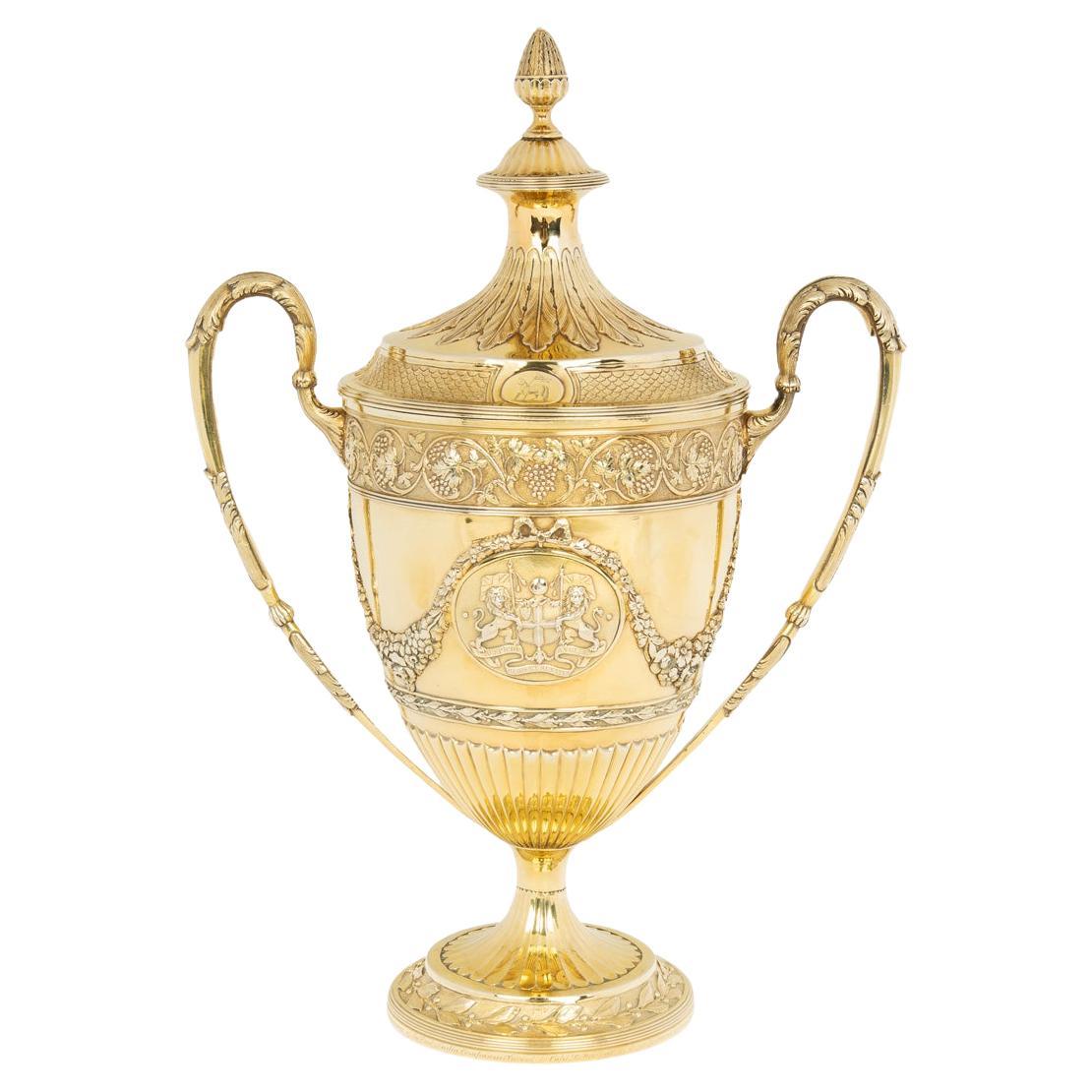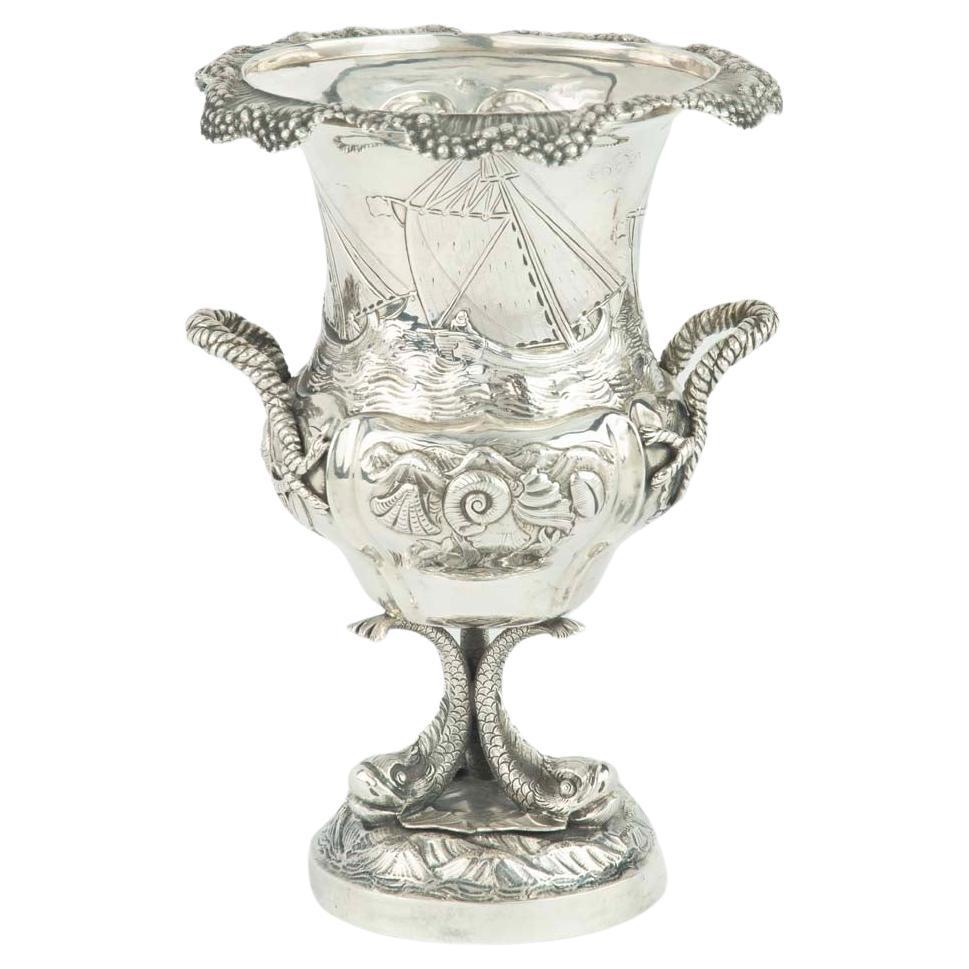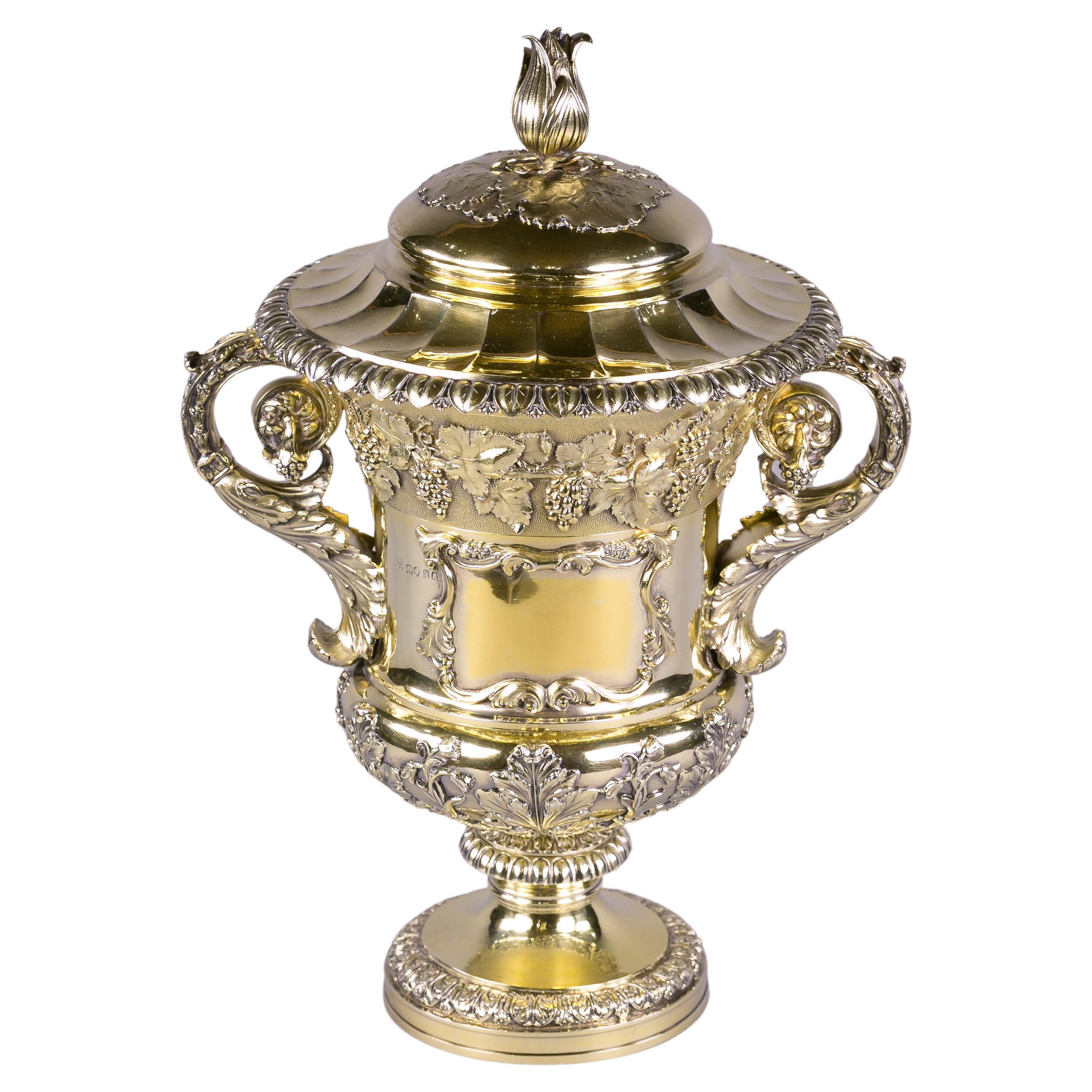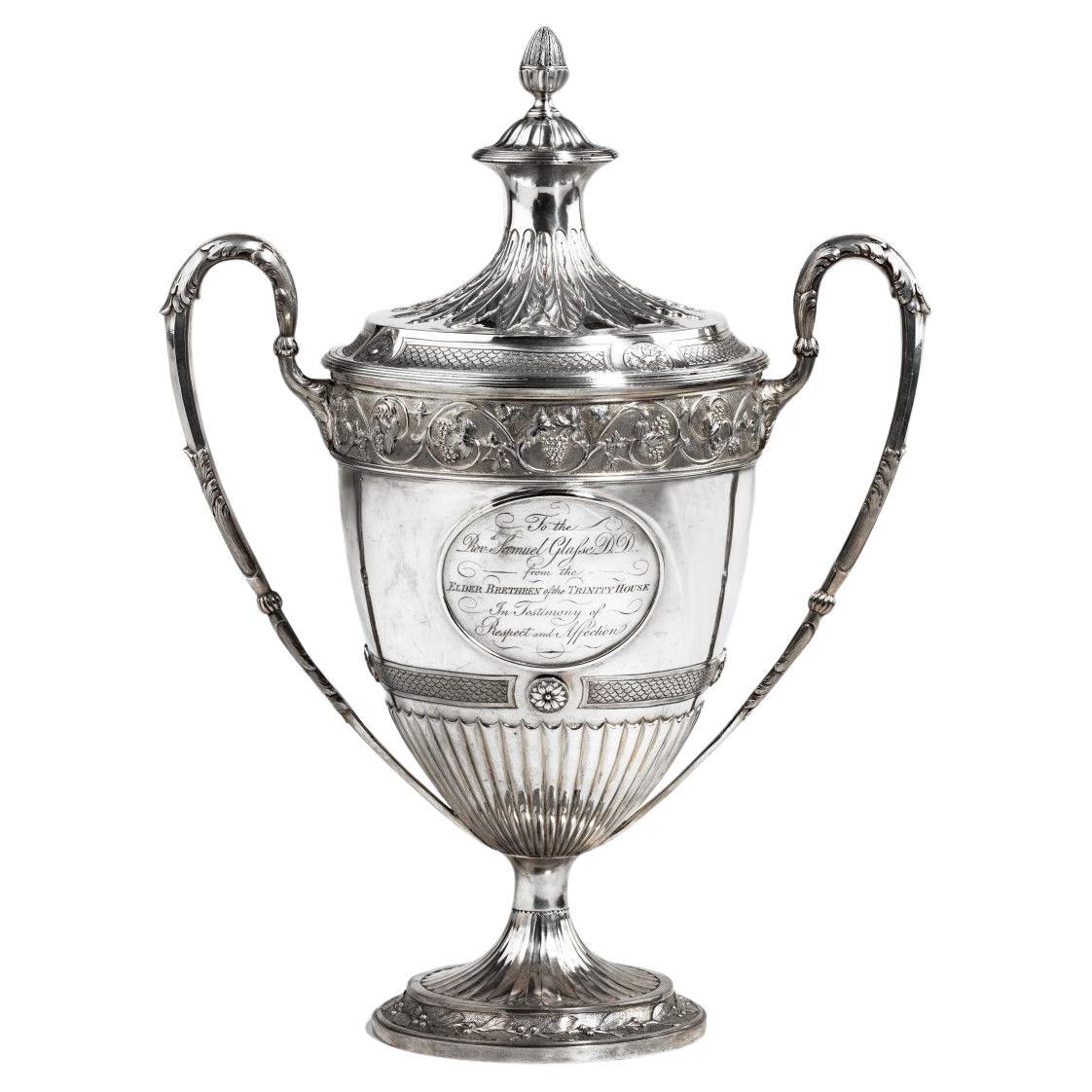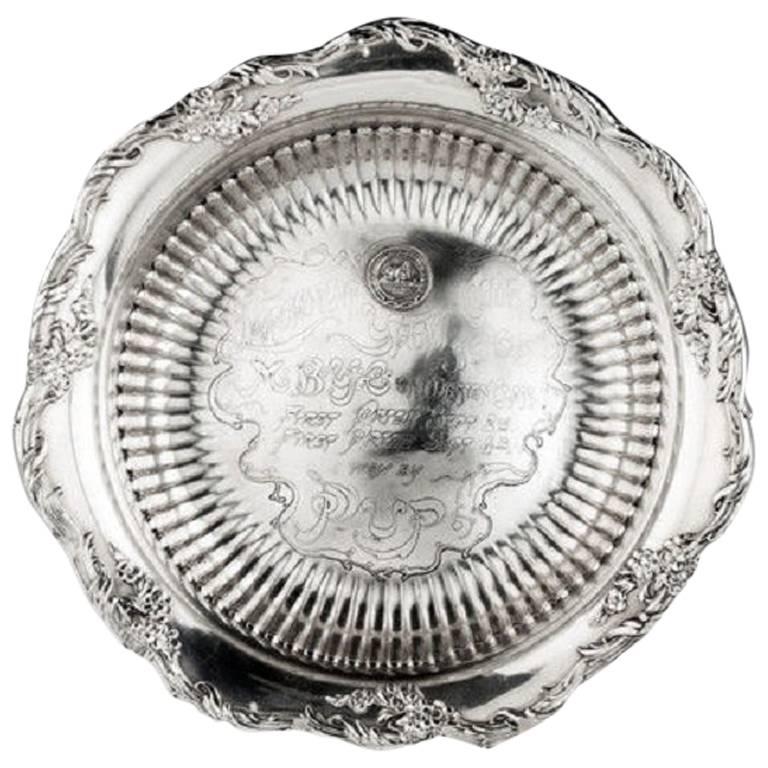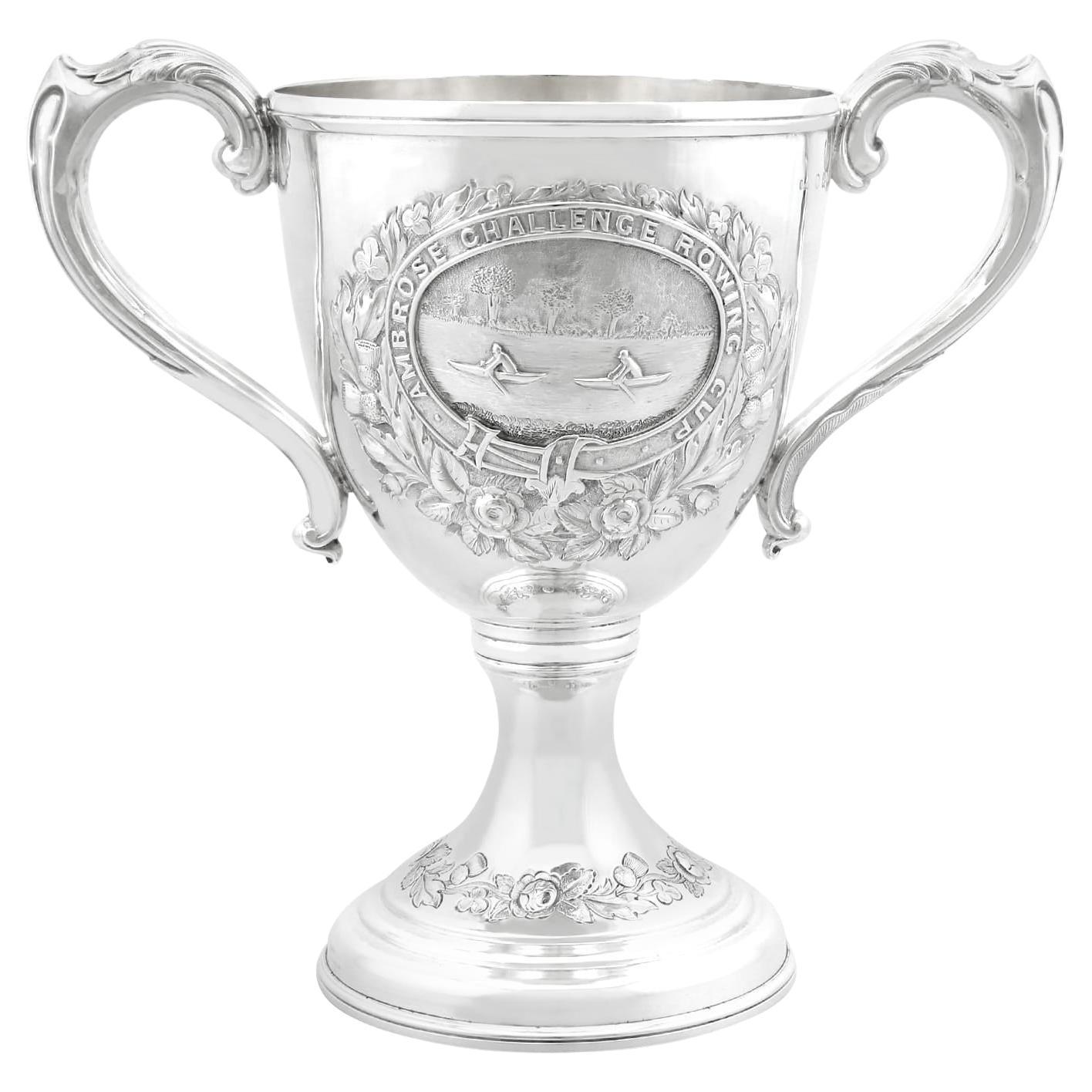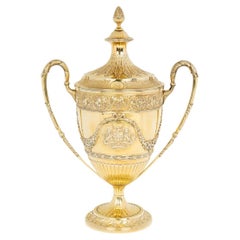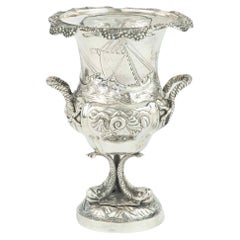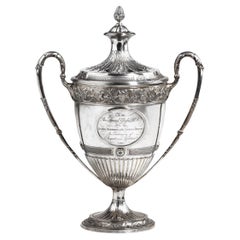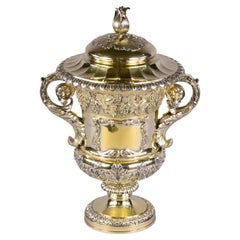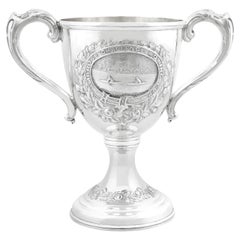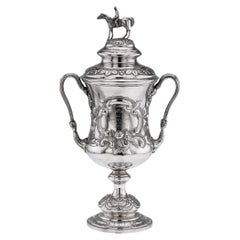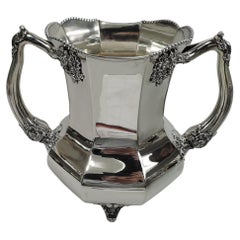Items Similar to An impressive silver gilt Lyme Regis & Charmouth Regatta Cup for 1846 presented
Want more images or videos?
Request additional images or videos from the seller
1 of 14
An impressive silver gilt Lyme Regis & Charmouth Regatta Cup for 1846 presented
$25,695.39
£18,750
€21,874.92
CA$35,196.26
A$39,145.92
CHF 20,440.78
MX$476,364.22
NOK 261,060
SEK 244,828.22
DKK 163,260.91
Shipping
Retrieving quote...The 1stDibs Promise:
Authenticity Guarantee,
Money-Back Guarantee,
24-Hour Cancellation
About the Item
An impressive silver gilt Lyme Regis & Charmouth Regatta Cup for 1846 presented by John Attwood M.P. made by Hunt and Roskell, in the form of a classical footed urn with paired handles and a domed lid surmounted by a dolphin, engraved throughout with collars of stippled waves and two central C-scroll cartouches, one stating ‘The Gift of I Attwood Esq.r MP to the Lyme Regis & Charmouth Regatta 18 August 1846’, fully assayed. English, 1846.
The Lyme Regis Regatta is believed to have been established around 1825 and continued uninterrupted every August until 1889, being re-established in 1898. The Lyme Regis Regatta generally is discussed in Ebb and Flow: The Story Of Maritime Lyme Regis by Peter Lacey.
It is evident that in Victorian Lyme Regatta Day was the high point of the season for both inhabitants and visitors. Traditionally held in August, Lyme Regis Annual Regatta Day started around 1825; its forerunner in 1810 being a boat race held once a year. Yacht races were the main feature of these early regattas and in 1847 there were three such races with silver cups to the value of £100 being presented to the gentlemen winners, races for trawl boats and rowing matches included. Competitors competed for generous prize money and sponsorship of regattas was viewed as a civic obligation, contributions coming from gentlemen and principal tradesmen of the town. In 1889 the regatta was discontinued, but resurrected in 1898 and incorporated an extensive schedule of sailing and rowing races. Lyme ketches competed for the Earl De La Warr’s silver cup and £10 of shared prize money and The Dorset Challenge Cup race involved open sail boats. Both races stipulated ‘The cup to be won two years by the same boat before becoming the property of the winner‘. Lyme and Charmouth were pitted against each other in sailing and rowing events. From ‘Ebb and Flow The Story Of Maritime Lyme Regis’ by Peter Lace.
The 1846 Regatta
A newspaper report from the 1st of August 1846 in the Exeter and Plymouth Gazette previewed the event, scheduled for the 18th of August. It stated that “A silver cup, value 35 Guineas, presented by John Attwood Esq., M.P., for yachts not exceeding 35 tons. Old Admeasurement”. In actual fact the weather on the 18th was poor and so the race was not able to take place on that date, taking place on the 19th of August instead. There were three starters in competition for the cup:
The Lily of Devon (30 tons) owned by W. F. Moore Esq. and under the Royal Western Yacht Club (Plymouth) flag
The Geraldine, owned by “_ Fitzgerald” (sic) and under the Royal Thames Yacht Club flag
The Grand Turk (29 tons) owned by Thomas Fox Esq. and under the Royal Western Yacht Club (Plymouth) flag
The race was described in Bell’s Life in London and Sporting Chronicle, Sunday 30 August 1846 in great detail as follows:
“The interesting match of the day was between two crack clippers of the R. W. Y. C…..The Geraldine, R. T. Y. C., belonging to _Fitzgerald Esq., also entered for this cup but the breeze was too strong to give her a chance against her more powerful antagonists. The race started with a fine breeze at west, and in running down off the wind to the eastern mark boat, the Grand Turk headed her opponent, but on hauling their wind to fetch the southern mark boat, the breeze freshened, and the sailing between these two yachts was most interesting. Each had at this time as much canvas as she could drag under, with a head sea, and in a very short time the Lily both weathered and passed the other, and there appeared little doubt of her winning, but, unfortunately, when at some distance ahead, she carried away her weather cross tree, and was in consequence obliged to take in her gaff topsail, which gave the Grand Turk the advantage, and she succeeded in reaching and passing the starting boat about a minute before the Lily. By this time the Lily had got her small gaff topsail set and she again looked as if determined to wrest the cup from the other. On rounding the eastern mark boat for the second time she again came up close to the Grand Turk, and the latter, finding that she could not contend with her opponent against a head sea, most judiciously tacked, obliging the Lily to do the same. The race was now most exciting, the two vessels almost touching each other when tacking; the Lily to leeward of her antagonist, and partially becalmed by her sails. The Lily now edged away to leeward, thinking to pass by this means, and get again fairly in to the breeze. She had scarcely done so before the strop of the inner block of her peak halyards broke short off, which caused the peak of the sail to drop, and it was some time before it again could be hoisted, and the sail again made to stand. It was now evident that the Grand Turk must win, unless she met with some casualty, but she proved herself to be not only a very fast but a fortunate vessel, coming in the winner by three minutes and a half. The way in which the Grand Turk was handled by her crew excited much admiration. Two more splendid cutters than the Lily of Devon and the Grand Turk, of their tonnage, cannot we think, be found amongst any of the yacht clubs”.
John Attwood was the M. P. for Harwich in Essex and lived in a grand mansion Hylands Park in Chelmsford which still stands today, expanding the already large house at great expense.
Attwood had made his fortune as the owner of an ironworks in Birmingham but having achieved his goal and become a politician, by decidedly underhand means including bribery and other widespread corruption, he had a very short career. Elected in 1841, the accounts of the bribery used by his electoral agents led to him being forced out of parliament in 1848. Attwood had dreamed of getting a peerage, completing his journey from working man to gentleman, but died in disgrace and poverty in France hiding from his creditors in 1865.
Hunt and Roskell
A continuation of the firm set up by the great Paul Storr after leaving Rundell, Bridge and Rundell, Hunt and Roskell were the most important firm of silversmiths in the mid to late 19th century in London with royal warrants awarded by Queen Victoria and by the French emperor. They won countless awards at the International Exhibitions held during this period, including the Great Exhibition of 1851, and the firm continued independently until 1889 when it became part of the J. W. Benson company, still trading as Hunt and Roskell, until it was closed in 1965.
- Dimensions:Height: 13.5 in (34.29 cm)Width: 8.5 in (21.59 cm)Depth: 6.35 in (16.13 cm)
- Materials and Techniques:
- Place of Origin:
- Period:
- Date of Manufacture:1846
- Condition:Wear consistent with age and use.
- Seller Location:Lymington, GB
- Reference Number:1stDibs: LU973036896752
About the Seller
5.0
Recognized Seller
These prestigious sellers are industry leaders and represent the highest echelon for item quality and design.
Established in 1982
1stDibs seller since 2013
132 sales on 1stDibs
Typical response time: 2 hours
Associations
LAPADA - The Association of Arts & Antiques Dealers
- ShippingRetrieving quote...Shipping from: Lymington, United Kingdom
- Return Policy
Authenticity Guarantee
In the unlikely event there’s an issue with an item’s authenticity, contact us within 1 year for a full refund. DetailsMoney-Back Guarantee
If your item is not as described, is damaged in transit, or does not arrive, contact us within 7 days for a full refund. Details24-Hour Cancellation
You have a 24-hour grace period in which to reconsider your purchase, with no questions asked.Vetted Professional Sellers
Our world-class sellers must adhere to strict standards for service and quality, maintaining the integrity of our listings.Price-Match Guarantee
If you find that a seller listed the same item for a lower price elsewhere, we’ll match it.Trusted Global Delivery
Our best-in-class carrier network provides specialized shipping options worldwide, including custom delivery.More From This Seller
View AllThe large and interesting silver gilt trophy of Captain George
Located in Lymington, Hampshire
The large and interesting silver gilt trophy of Captain George Welstead, purchased with prize money from the East India Company, 1805, in the form of a footed cup with a separate cov...
Category
Antique 18th Century English Nautical Objects
Materials
Silver
The Luska Bay Regatta Challenge Cup won by Surprise, 1878
Located in Lymington, Hampshire
This ornate repoussé silver trophy is in the form of a handled cup with an everted rim and tripod dolphin base. The high relief decoration comprises three gaff rigged yachts racing,...
Category
Antique 1870s English Sports Equipment and Memorabilia
Materials
Silver
Trinity House silver presentation cup and cover 1795
Located in Lymington, Hampshire
Trinity House silver presentation cup and cover, 1795. This cup is modelled in the classical style with a fluted foot chased with a band of laurel leaves supporting the fluted lower ...
Category
Antique 1790s English Sterling Silver
Materials
Silver
Larchmont Yacht Club Silver Racing Trophy
Located in Lymington, Hampshire
An American silver trophy bowl from the Larchmont Yacht Club, New York State, presented to the yacht 'Pup' in 1905, winner of the MBYC (Mission Bay ...
Category
Antique Early 1900s American Sports Equipment and Memorabilia
Materials
Silver
George III Lloyds Patriotic Fund Silver and Silver Gilt Vase and Cover by Samuel
Located in Lymington, Hampshire
George III Lloyds patriotic fund silver and silver gilt vase and cover by Samuel Hennell, of Adam design, the lift-off cover with knop finial above an...
Category
Antique Early 1800s English Nautical Objects
Materials
Silver
A silver presentation bowl by Mappin and Webb presented to Lionel de Rothschild
Located in Lymington, Hampshire
A silver presentation bowl by Mappin and Webb presented to Lionel de Rothschild, 1912. This wide two handled cup by Mappin and Webb was created as a gift for Lionel de Rothschild as ...
Category
Vintage 1910s English Sterling Silver
Materials
Silver
You May Also Like
English Georgian Silver Gilt Covered Cup, Dated 1825
Located in New York, NY
With a racing scene in high relief. Marked: London, 1825, Makers: Emes and Barnard.
Category
Antique 1820s Sterling Silver
Materials
Sterling Silver
Victorian English Sterling Silver Trophy Cup with Rowing Interest
By Hilliard & Thomason
Located in Jesmond, Newcastle Upon Tyne
An exceptional, fine and impressive, antique Victorian English sterling silver trophy cup with rowing interest; an addition to our Victorian silverware collection.
This exceptional antique Victorian sterling silver presentation cup has a bell-shaped form to a circular domed foot.
Either side of the body of this silver trophy cup is embellished with an impressive applied oval belted garter bordered cartouche encompassed with a paralleling embossed floral and foliate decorated wreath design; the cartouche to one side remains vacant.
The cartouche to the opposing side incorporates the elucidating presentation title 'Ambrose Challenge Rowing Cup', in addition to a scene of two row boats in competition with a riverbed in the background.
The upper rim of the cup is encompassed with an applied moulded decorated border.
This impressive Victorian trophy cup is fitted with an exceptional pair of embossed sterling silver scrolling handles, accented with leaf decorated thumbpieces.
The cup is supported by a waisted pedestal and circular domed foot accented with further embossed foliate ornamentation.
Condition:
This antique silver rowing trophy...
Category
Vintage 1970s British Victorian Centerpieces
Materials
Silver, Sterling Silver
Antique 19th Century Indian Colonial Solid Silver Trophy Cup & Cover c.1860
By Charles, Nephew & Co. 1
Located in Royal Tunbridge Wells, Kent
Antique 19th Century Indian Colonial solid silver trophy cup and cover, exceptionally heavy and decorative, campana form on a spreading foot, domed lid chased and embossed with folia...
Category
Antique 19th Century Indian Other Centerpieces
Materials
Silver
Antique Reed & Barton American Edwardian Classical Sterling Silver Trophy Cup
By Reed & Barton
Located in New York, NY
Turn-of-the-century Edwardian sterling silver trophy cup. Made by Reed & Barton in Taunton, Mass. Faceted baluster with scalloped and beaded rim. Reeded and leaf-capped, -wrapped, an...
Category
Early 20th Century American American Classical Sterling Silver
Materials
Sterling Silver
Fabulous Hand Chased English Sheffield Silver Plate Trophy or Loving Cup
By Martin, Hall & Co. Ltd.
Located in CHARLESTON, SC
Fabulous antique English Sheffield silver plate trophy or loving cup with exceptional crisp hand chasing on cup and on base. Two large cartouches on either side suitable for engravin...
Category
Antique Mid-19th Century English Sheffield and Silverplate
Materials
Silver Plate
English Silver Plated Handled Trophy Cup Decorative Vase / Urn
By Sheffield Silver Co.
Located in Tarry Town, NY
Unveil the epitome of elegance with This English sheffield silver plate two handled trophy cup decorative vase / urn. This remarkable piece, crafted with meticulous attention to deta...
Category
Antique 1880s English Victorian Vases
Materials
Silver Plate
